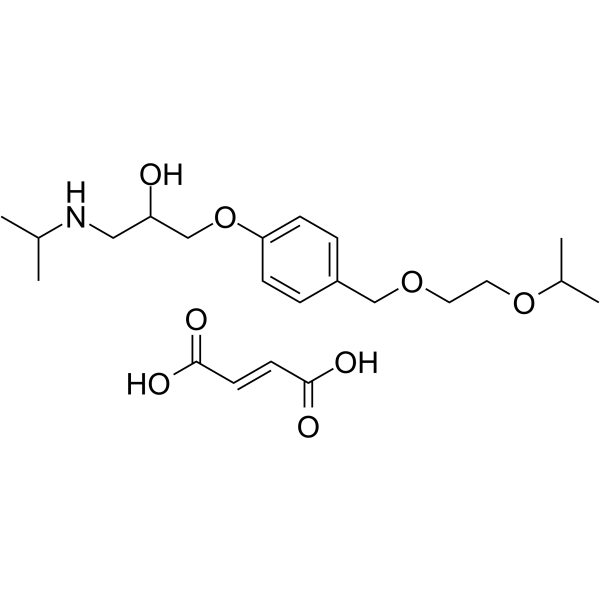Bisoprolol (fumarate)
Modify Date: 2025-08-25 17:33:05

Bisoprolol (fumarate) structure
|
Common Name | Bisoprolol (fumarate) | ||
|---|---|---|---|---|
| CAS Number | 105878-43-1 | Molecular Weight | N/A | |
| Density | N/A | Boiling Point | N/A | |
| Molecular Formula | C22H35NO8 | Melting Point | N/A | |
| MSDS | N/A | Flash Point | N/A | |
Use of Bisoprolol (fumarate)Bisoprolol fumarate is a potent, selective and orally active β1-adrenergic receptor blocker with little activity on β2-receptor. Bisoprolol fumarate has the potential for hypertension, coronary artery disease and stable ventricular dysfunction research[1][2]. |
| Name | Bisoprolol (fumarate) |
|---|---|
| Synonym | More Synonyms |
| Description | Bisoprolol fumarate is a potent, selective and orally active β1-adrenergic receptor blocker with little activity on β2-receptor. Bisoprolol fumarate has the potential for hypertension, coronary artery disease and stable ventricular dysfunction research[1][2]. |
|---|---|
| Related Catalog | |
| Target |
Beta-1 adrenergic receptor |
| In Vitro | Bisoprolol fumarate (2 μM, 1 h) protects myocardial cells (H9c2) from ischemia/reperfusion (I/R) injury[2]. Bisoprolol fumarate (2 μM, 1 h) reduces the H/R-induced ROS production and apoptosis in H9c2 cells[2]. Bisoprolol fumarate (2 μM, 1 h) increases AKT and GSK3β phosphorylation in H9c2 cells[2]. Bisoprolol fumarate (100 μM, 24 h) reverses Epinephrine-inhibited emigration in cholesterol-loaded DCs (dendritic cell) through increasing in β-arrestin 2, CCR7 and PI3K phosphorylation[3]. Cell Viability Assay[2] Cell Line: H9c2 cells Concentration: 0.2, 2, 20 μM Incubation Time: 1 h Result: Elevated the survival rates of cardiomyocytes subjected to H/R (hypoxia/reoxygenation) to 73.20%, 90.38%, 81.25% respectively. Cell Migration Assay [3] Cell Line: DCs Concentration: 100 μM Incubation Time: 6, 12, 24 h Result: Increased the amount of migrating cells by 46.00% (6 h), 64.25% (12 h) and 55.74% (24 h). |
| In Vivo | Bisoprolol fumarate (oral administration, 5 mg/kg, for 1 week) increases left ventricular ejection fraction (LVEF) and decreases the heart rate value[2]. Bisoprolol fumarate (oral gavage, 8 mg/kg, daily for four weeks) shows protective effects against Cadmium-induced myocardial toxicity in rats[4]. Bisoprolol fumarate (oral gavage, 1 mg/kg, daily for 6 weeks) reversessmall conductance calcium-activated potassium channel (SK) remodeling in a volume-overload rat model[5]. Animal Model: Ischemia/reperfusion (I/R) injury rats[2] Dosage: 0.5, 5, 10 mg/kg Administration: Oral administration, for 1 week, prior to 0.5 h ischemia/4 h reperfusion. Result: Reduced infarct size from 44% in I/R group to 31% in treated group. Animal Model: Cadmium-induced rats[4] Dosage: 2, 8 mg/kg Administration: Oral gavage, daily for four weeks. Result: Decreased mean arterial pressure (MAP) at 8 mg/kg. Decreased serum biomarkers (ALT, AST) and NF-kB p65 expression and TNF-α levels (cardiac tissue samples) at 8 mg/kg. |
| References |
| Molecular Formula | C22H35NO8 |
|---|
| Bisoprolol fumarate |
| 1-(propan-2-ylamino)-3-(4-{[2-(propan-2-yloxy)ethoxy]methyl}phenoxy)propan-2-ol (2E)-but-2-enedioate (1:1) |
| BISOPROLOL MONOFUMARATE, (S)- |
| MFCD00673957 |
| BISOPROLOL MONOFUMARATE, (R)- |
| Bisoprolol (fumarate) |
| Bisoprolol fumarate (1:x) |
| MFCD00792743 |
| 1-{4-[(2-Isopropoxyethoxy)methyl]phenoxy}-3-(isopropylamino)-2-propanol (2E)-2-butenedioate (1:1) |
| 2-Propanol, 1-[4-[[2-(1-methylethoxy)ethoxy]methyl]phenoxy]-3-[(1-methylethyl)amino]-, (2E)-2-butenedioate (1:1) (salt) |
| Bisoprolol hemifumarate |
| 1-{4-[(2-Isopropoxyethoxy)methyl]phenoxy}-3-(isopropylamino)propan-2-ol (2E)-but-2-enedioate (1:1) |
| BISOPROLOL MONOFUMARATE |